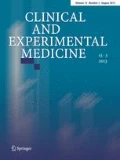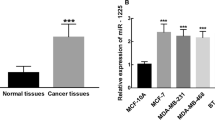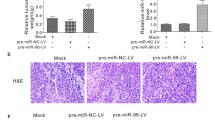Abstract
Previous researches have indicated that miR-4317 was aberrantly expressed in several tumors. However, the potential role of miR-4317 in breast cancer is still unclear. The aim of this study was to investigate the potential role of miR-4317 in breast cancer. The relative expression levels of miR-4317 were detected in breast cancer tissues and cell lines using qRT-PCR analysis. The Kaplan–Meier survival curve and multivariate Cox regression analyses were used to investigate the prognostic significance of miR-4317 in breast cancer. CCK-8 and Transwell assays were performed to evaluate the effects of miR-4317 on cell proliferation, migration, and invasion. The results showed that miR-4317 expression was decreased in breast cancer tissues and cell lines. Downregulation of miR-4317 was significantly associated with lymph node metastasis, TNM stage, and poor prognosis. Overexpression of miR-4317 inhibited proliferation, migration, and invasion of breast cancer cells, while downregulation of miR-4317 exhibited the opposite effects. MYD88 may be a direct target of miR-4317. The results suggest miR-4317 may play a tumor suppressor role in breast cancer and inhibit proliferation, migration, and invasion of breast cancer cells by targeting MYD88. The findings provide novel evidence of miR-4317 as a potential prognostic biomarker and therapeutic target for breast cancer.





Similar content being viewed by others
Abbreviations
- miRNAs:
-
MicroRNAs
- mimic NC:
-
Mimic negative controls
- cDNA:
-
Complementary DNA
- qRT-PCR:
-
Quantitative real-time PCR
- CCK-8:
-
Cell counting kit-8
- ANOVA:
-
Analysis of variance
- NSCLC:
-
Non-small cell lung cancer
References
Harbeck N, Gnant M. Breast cancer. Lancet. 2017;389(10074):1134–50.
Chen W, Zheng R, Baade PD, et al. Cancer statistics in China, 2015. CA Cancer J Clin. 2016;66(2):115–32.
Zhou D, Ouyang Q, Liu L, et al. Chemotherapy modulates endocrine therapy-related resistance mutations in metastatic breast cancer. Transl Oncol. 2019;12(5):764–74.
Qian CN, Mei Y, Zhang J. Cancer metastasis: issues and challenges. Chin J Cancer. 2017;36(1):38.
de Castro Sant’ Anna C, Junior AGF, Soares P, et al. Molecular biology as a tool for the treatment of cancer. Clin Exp Med. 2018;18(4):457–64.
Jiang L, Zhang X, Geradts J, et al. Expression of tetraspanins NET-6 and CD151 in breast cancer as a potential tumor biomarker. Clin Exp Med. 2019;19(3):377–84.
Campos CZ, Losi Guembarovski R, de Oliveira CEC, et al. Glutathione S-transferases deletions may act as prognosis and therapeutic markers in breast cancer. Clin Exp Med. 2018;18(1):27–35.
Bartel DP. MicroRNAs: genomics, biogenesis, mechanism, and function. Cell. 2004;116(2):281–97.
Chen H, Yang Y, Wang J, Shen D, Zhao J, Yu Q. miR-130b-5p promotes proliferation, migration and invasion of gastric cancer cells via targeting RASAL1. Oncol Lett. 2018;15(5):6361–7.
Sun X, Cui S, Fu X, Liu C, Wang Z, Liu Y. MicroRNA-146-5p promotes proliferation, migration and invasion in lung cancer cells by targeting claudin-12. Cancer Biomark. 2019;25(1):89–99.
Guo H, Zhang L. MicroRNA-30a suppresses papillary thyroid cancer cell proliferation, migration and invasion by directly targeting E2F7. Exp Ther Med. 2019;18(1):209–15.
Liu Y, Duan N, Duan S. MiR-29a inhibits glioma tumorigenesis through a negative feedback loop of TRAF4/Akt signaling. Biomed Res Int. 2018;2018:2461363.
Huang GH, Shan H, Li D, Zhou B, Pang PF. MiR-199a-5p suppresses tumorigenesis by targeting clathrin heavy chain in hepatocellular carcinoma. Cell Biochem Funct. 2017;35(2):98–104.
Hannafon BN, Cai A, Calloway CL, et al. miR-23b and miR-27b are oncogenic microRNAs in breast cancer: evidence from a CRISPR/Cas9 deletion study. BMC Cancer. 2019;19(1):642.
Zhao C, Ling X, Li X, Hou X, Zhao D. MicroRNA-138-5p inhibits cell migration, invasion and EMT in breast cancer by directly targeting RHBDD1. Breast Cancer. 2019;26(6):817–25.
Zhao XG, Hu JY, Tang J, et al. miR-665 expression predicts poor survival and promotes tumor metastasis by targeting NR4A3 in breast cancer. Cell Death Dis. 2019;10(7):479.
Sand M, Skrygan M, Sand D, et al. Comparative microarray analysis of microRNA expression profiles in primary cutaneous malignant melanoma, cutaneous malignant melanoma metastases, and benign melanocytic nevi. Cell Tissue Res. 2013;351(1):85–98.
Janiszewska J, Szaumkessel M, Kostrzewska-Poczekaj M, et al. Global miRNA expression profiling identifies miR-1290 as novel potential oncomiR in laryngeal carcinoma. PLoS ONE. 2015;10(12):e0144924.
Danza K, De Summa S, Pilato B, et al. Combined microRNA and ER expression: a new classifier for familial and sporadic breast cancer patients. J Transl Med. 2014;12:319.
Tryfonidis K, Senkus E, Cardoso MJ, Cardoso F. Management of locally advanced breast cancer-perspectives and future directions. Nat Rev Clin Oncol. 2015;12(3):147–62.
Hart NH, Galvao DA, Saunders C, et al. Mechanical suppression of osteolytic bone metastases in advanced breast cancer patients: a randomised controlled study protocol evaluating safety, feasibility and preliminary efficacy of exercise as a targeted medicine. Trials. 2018;19(1):695.
Liu L, Tian YC, Mao G, Zhang YG, Han L. MiR-675 is frequently overexpressed in gastric cancer and enhances cell proliferation and invasion via targeting a potent anti-tumor gene PITX1. Cell Signal. 2019;62:109352.
Zhang L, Xu J, Yang G, Li H, Guo X. miR-202 inhibits cell proliferation, migration, and invasion by targeting epidermal growth factor receptor in human bladder cancer. Oncol Res. 2018;26(6):949–57.
Yang W, Bai J, Liu D, et al. MiR-93-5p up-regulation is involved in non-small cell lung cancer cells proliferation and migration and poor prognosis. Gene. 2018;647:13–20.
Wu M, Li X, Liu Q, Xie Y, Yuan J, Wanggou S. miR-526b-3p serves as a prognostic factor and regulates the proliferation, invasion, and migration of glioma through targeting WEE1. Cancer Manag Res. 2019;11:3099–110.
Li X, Xu M, Ding L, Tang J. MiR-27a: a novel biomarker and potential therapeutic target in tumors. J Cancer. 2019;10(12):2836–48.
Li C, Zhang J, Ma Z, Zhang F, Yu W. miR-19b serves as a prognostic biomarker of breast cancer and promotes tumor progression through PI3K/AKT signaling pathway. Onco Targets Ther. 2018;11:4087–95.
Li WJ, Xie XX, Bai J, Wang C, Zhao L, Jiang DQ. Increased expression of miR-1179 inhibits breast cancer cell metastasis by modulating Notch signaling pathway and correlates with favorable prognosis. Eur Rev Med Pharmacol Sci. 2018;22(23):8374–82.
Zhang J, He Y, Yu Y, et al. Upregulation of miR-374a promotes tumor metastasis and progression by downregulating LACTB and predicts unfavorable prognosis in breast cancer. Cancer Med. 2018;7(7):3351–62.
Zhang J, Tian ZL, Zhang WT, et al. Clinicopathological and prognostic significance of miR-4317 expression in gastric cancer patients. Eur Rev Med Pharmacol Sci. 2019;23(7):2803–8.
He X, Chen SY, Yang Z, et al. miR-4317 suppresses non-small cell lung cancer (NSCLC) by targeting fibroblast growth factor 9 (FGF9) and cyclin D2 (CCND2). J Exp Clin Cancer Res. 2018;37(1):230.
Hu X, Zhang M, Miao J, Wang X, Huang C. miRNA-4317 suppresses human gastric cancer cell proliferation by targeting ZNF322. Cell Biol Int. 2018;42(8):923–30.
Xu X, Yin Y, Tang J, et al. Long non-coding RNA Myd88 promotes growth and metastasis in hepatocellular carcinoma via regulating Myd88 expression through H3K27 modification. Cell Death Dis. 2017;8(10):e3124.
Ngo VN, Young RM, Schmitz R, et al. Oncogenically active MYD88 mutations in human lymphoma. Nature. 2011;470(7332):115–9.
Xiang F, Ni Z, Zhan Y, et al. Increased expression of MyD88 and association with paclitaxel resistance in breast cancer. Tumour Biol. 2016;37(5):6017–25.
Author information
Authors and Affiliations
Contributions
YS, RH, and YZ initiated and designed the experiments, analyzed data, and drafted and revised the manuscript. WL conceived and designed the manuscript. All authors have read and approved the final manuscript.
Corresponding author
Ethics declarations
Conflict of interest
The authors declare that they have no conflict of interest.
Availability of data and materials
The dataset supporting the conclusions of this article is included within the article.
Ethics approval and consent to participate
This study was approved by the Ethics Committee of the Shanghai First People’s Hospital Baoshan Branch, and written informed consent was signed by all patients.
Consent for publication
Written informed consent for publication was obtained from each participant.
Additional information
Publisher's Note
Springer Nature remains neutral with regard to jurisdictional claims in published maps and institutional affiliations.
Rights and permissions
About this article
Cite this article
Sheng, Y., Hu, R., Zhang, Y. et al. MicroRNA-4317 predicts the prognosis of breast cancer and inhibits tumor cell proliferation, migration, and invasion. Clin Exp Med 20, 417–425 (2020). https://doi.org/10.1007/s10238-020-00625-4
Received:
Accepted:
Published:
Issue Date:
DOI: https://doi.org/10.1007/s10238-020-00625-4




